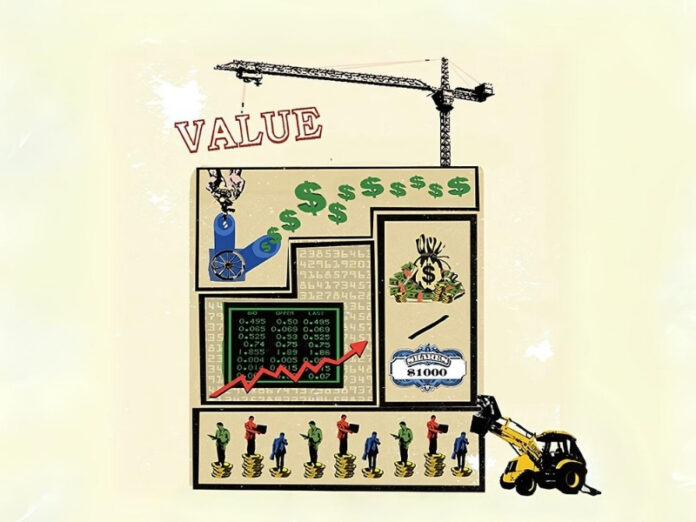By Tim Koller, Richard Dobbs and Bill Huyett
Most executives have figured out how to create value for shareholders through experience, observation, and intuition. They’ve developed a wealth of personal wisdom that typically takes them in the right direction. But let’s face it: that wisdom doesn’t always prevail.
Most executives have figured out how to create value for shareholders. Through experience, observation, and intuition, they’ve developed a wealth of personal wisdom that, with some luck, typically takes them in the right direction.
But let’s face it: that wisdom doesn’t always prevail. Indeed, the run-up to the financial crisis of 2008 is but one example of how easily finance myths, fads, and misconceptions overwhelm wisdom, even in the most sophisticated organizations.
Executives don’t have it easy. It’s tough to hold steady when shareholders expect absurdly high returns during periods of relative alignment between companies’ share prices and underlying economic value. It’s even tougher to stick with fundamentals as peers’ profits skyrocket in seemingly irrational ways, as they did in 2008, or when share prices reach unprecedented and unsustainable levels, as they did during the Internet-bubble era.
During such periods, seductive new economic theories emerge. These theories catch the attention of journalists, traders, boards, investors, and executives—even though they’re blatantly at odds with the tenets of finance that have held true for more than 100 years.
These episodes of wishful thinking have only reinforced the immutable principles of value creation. These four principles—the cornerstones of corporate finance—start with the axiom that companies exist to meet customer needs in a way that translates into reliable returns to investors.
These four principles-the cornerstones of corporate finance-start with the axiom that companies exist to meet customer needs in a way that translates into reliable returns to investors.
Together, the cornerstones form a foundation upon which executives can ground decisions about strategy, M&A, budgets, financial policy, technology, and performance measurement—even as markets, economies, and industries change around them.
The cornerstones
The first and guiding cornerstone is The Core of Value. It states that companies create value by investing capital from investors to generate future cash flows at rates of return exceeding the cost of that capital. This combination of growth and return on capital (ROIC) explains why some companies typically trade high price to earnings (P/E) multiples despite low growth. In the branded consumer products industry, for instance, the global confectioner Hershey Company’s P/E was 18 times at the end of 2009, which was higher than 70 percent of the 400 largest U.S. nonfinancial companies. Yet, Hershey’s revenue growth rate has been in the 3 to 4 percent range.
What’s important about this is that where a business stands in terms of growth and ROIC can drive significant changes in its strategy. For businesses with high returns on capital, improvements in growth create the most value. But for businesses with low returns, improvements in ROIC provide the most value.
The second cornerstone is The Conservation of Value, and is a corollary of the first. It states that value is created when companies generate higher cash flows, not by rearranging investors’ claims on those cash flows. When a company substitutes debt for equity or issues debt to repurchase shares, for instance, it changes the ownership of claims to its cash flows. However, this doesn’t change the total available cash flows or add value (unless tax savings from debt increase the company’s cash flows). Similarly, changing accounting techniques may create the illusion of higher performance without actually changing the cash flows, so it won’t change the value of a company.
The third cornerstone is The Expectations Treadmill. It recognizes that a company’s performance in the stock market is driven by changes in the stock market’s expectations, not just the company’s actual performance. The higher the stock market’s expectations, the better a company has to perform just to keep up. The large American retailer Home Depot, for instance, lost half the value of its shares from 1999 through 2009, despite growing revenues by 11 percent per year during the period at an attractive ROIC. The decline in value can mostly be explained by Home Depot’s unsustainably high value in 1999 at $132 billion, the justification of which would have required revenue growth of 26 percent per year for 15 years (a very unlikely, if not impossible, feat).
As the old adage says, good companies aren’t necessarily good investments. In a world where executive compensation is heavily linked to share-price performance over relatively short time periods, it’s often easier for executives to earn more by turning around a weak performer than by taking a high-performing company to an even higher level.
The fourth and final cornerstone of corporate finance is that the value of a business depends on who is managing it and what strategy they pursue. This is The Best Owner principle. It says that different owners will generate different cash flows for a given business based on their unique abilities to add value. Related to this is the idea that there is no such number as an inherent value for a business. Different owners will create value in different ways, and some will have more value-generating potential than others.
Consequences of not valuing value
When managers, boards of directors, and investors have forgotten these simple truths, the consequences have been disastrous. The rise and fall of business conglomerates in the 1970s, hostile takeovers in the United States in the 1980s, the collapse of Japan’s bubble economy in the 1990s, the Southeast Asian crisis in 1998, the Internet bubble, and the economic crisis starting in 2007—all of these can be traced to a misunderstanding or misapplication of the cornerstones. During the Internet bubble, for instance, managers and investors lost sight of what drives ROIC, and many even forgot its importance entirely.
Between 1995 and 2000, more than 4,700 companies went public in the United States and Europe, many with billion-dollar-plus market capitalizations. Some of the companies born in this era, including Amazon, eBay, and Yahoo!, have created and are likely to continue creating substantial profits and value. But for every solid, innovative new business idea, there were dozens of that couldn’t similarly generate revenue or cash flow in either the short or long term. The initial stock market success of these companies represented a triumph of hype over experience.
Ignoring the cornerstones also underlies the current financial crisis. When banks and investors forgot the conservation-of-value principle, they took on a level of risk that was unsustainable.
Ignoring the cornerstones also underlies financial crises, such as the one that began in 2007. When banks and investors forgot the conservation-of-value principle, they took on a level of risk that was unsustainable.
First, homeowners and speculators bought homes—essentially illiquid assets. They took out mortgages with interest set at artificially low teaser rates for the first few years, but then those rates rose substantially. Both the lenders and buyers knew that buyers couldn’t afford the mortgage payments after the teaser period. But both assumed that either the buyer’s income would grow by enough to make the new payments, or the house value would increase enough to induce a new lender to refinance the mortgage at similarly low teaser rates. Banks packaged these high-risk debts into long-term securities and sold them to investors. The securities, too, were not very liquid, but the investors who bought them, typically hedge funds and other banks, used short-term debt to finance the purchase, thus creating a long-term risk for those who lent the money.
When the interest on the homebuyers’ adjustable rate increased, many could no longer afford the payments. Reflecting their distress, the real estate market crashed, pushing the value of many homes below the value of loans taken out to buy them. At that point, homeowners could neither make the required payments nor sell their houses. Seeing this, the banks that had issued short-term loans to investors in securities backed by mortgages became unwilling to roll those loans over, prompting all the investors to sell their securities at once.
The value of the securities plummeted. Finally, many of the large banks themselves had these securities on their books, which they, of course, had also financed with short-term debt that they could no longer roll over.
This story reveals two fundamental flaws in the decisions taken by participants in the securitized mortgage market. First, they all assumed that securitizing risky home loans made them more valuable because it reduced the risk of the assets—but this violates the conservation of-value rule. The aggregated cash flows of the home loans were not increased by securitization, so no value was created and the initial risks remained.
Securitizing the assets simply enabled risks to be passed on to other owners; some investors, somewhere, had to be holding them. After the housing market turned, financial service companies feared that any of their counterparties could be holding massive risks and almost ceased to do business with one another. This was the start of the credit crunch that triggered a protracted recession in the real economy.
The second flaw in thinking made by decision-makers during the past economic crisis, was in believing that using leverage to make an investment in itself creates value. It doesn’t because, according to the conservation-of-value principle, leverage doesn’t increase the cash flows from an investment. Many banks, for example, used large amounts of short-term debt to fund their illiquid long-term assets. This debt didn’t create long-term value for shareholders in those banks. On the contrary, it increased the risks of holding their equity.
Challenges for executives
The key to avoiding such crises is to reassert the fundamental economic rules. There’s no doubt that focusing on ROIC and revenue growth over the long term is a tough job for executives—and they won’t take it on unless they’re sure it wins them more investors and a stronger share price. But the evidence is overwhelming that investors do indeed value long-term cash flow, growth, and ROIC, and companies that perform well on these measures perform well in the stock market.
Still, despite the evidence that shareholders value value, companies continue to listen to misguided advice about what the market wants. They fall for the promise of creating value in various unproven ways, such as questionable accounting treatments, elaborate financial structures, or a myopic focus on earnings per share (EPS). But this won’t happen.
When analyzing a prospective acquisition, the question often posed is whether the transaction will accrete or dilute EPS over the first year or two. It doesn’t matter. No empirical link exists showing that predicted EPS accretion or dilution is an important indicator of whether an acquisition will create or destroy value. Deals that strengthen EPS and deals that dilute EPS are equally likely to create or destroy value.
But if such concepts like EPS dilution/accretion and the like are fallacies, why do they prevail? Why, despite the simple and intuitive nature of finance, do executives frequently make decisions that defy axiomatic principles and their own instincts?
In our recent discussion with a company and its bankers, the EPS dilution question came up. To paraphrase one of the bankers: “We know that any impact on EPS is irrelevant to value, but we use it as a simple way to communicate with boards of directors.” Yet company executives say they too don’t believe the impact on EPS is so important. They tell us they’re just using the measures that Wall Street uses. As well, investors tell us that the short-term impact of a deal on EPS is not that important for them. In sum, we hear from almost everyone that a transaction’s short-term impact on EPS doesn’t matter, yet they all pay homage to it.
We hear from almost everyone that a transaction’s short-term impact on EPS doesn’t matter, yet they all pay homage to it. This type of groupthink and lack of valuing value often leads to decisions that either erode value or pass up opportunities to create value.
This type of groupthink and lack of valuing value often leads to decisions that either erode value or pass up opportunities to create value. In fact, trying to correlate earnings growth with value creation is a fool’s game, because creating longer-term value often necessitates some decisions that reduce earnings in the short term—like investing in product development, for example.
Managers can find themselves under particular pressure when businesses mature and their growth moderates, but investors go on baying for high growth. In these situations, managers can be tempted to find ways to keep profits rising in the short term while they try to stimulate growth in the longer term. To be sure, there are situations where raising shorter-term profits should be a priority, and sorting out the tradeoffs between short-term earnings and long-term value creation is part of a manager’s job. But short-term efforts to massage earnings (that undercut productive investment) make achieving long-term growth even more difficult, spawning a vicious downward spiral.
Executives need independence and courage to apply the principles of value creation. Just as important, boards need to understand the economics of the businesses in their portfolio well enough to judge when managers are making the right trade-offs and, above all, to protect managers when they choose to build long-term value at the expense of short-term profits. The result will be lasting corporate value.





























![“Does Everyone Hear Me OK?”: How to Lead Virtual Teams Effectively iStock-1438575049 (1) [Converted]](https://www.europeanbusinessreview.com/wp-content/uploads/2024/11/iStock-1438575049-1-Converted-100x70.jpg)




